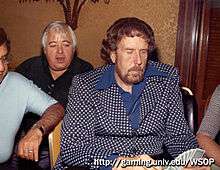Jack Straus
| Jack Straus | |
|---|---|
 Jack "Treetop" Straus | |
| Nickname(s) | Treetop |
| Born | June 16, 1930 |
| Died |
August 17, 1988 (age 58) Los Angeles, California |
| World Series of Poker | |
| Bracelet(s) | 2 |
| Money finish(es) | 4 |
| Highest ITM Main Event finish | Winner, 1982 |
Jack "Treetop" Straus (June 16, 1930 - August 17, 1988) was an American professional poker player.
He is best known for winning the 1982 World Series of Poker Main Event, where he was able to come back from being down to one chip earlier in the tournament, which gave meaning to the poker phrase "a chip and a chair".[1] In addition, Straus is known for successfully pulling off one of the best bluffs in the history of poker.
Poker career
Straus began playing in World Series of Poker events in the early 1970s. He finished in fourth place in the 1972 Main Event. He won his first bracelet in 1973 in the $3,000 Deuce to Seven Draw event and also finished in third place in the Main Event that year.
He won the 1982 World Series of Poker main event, earning $520,000 and a second WSOP bracelet. His appearances at the final table of the main event in 1972, 1973, and 1982 put him in a small elite group players to have made the final table three or more times. Other players to have done this include Main Event champions like Johnny Moss, Doyle Brunson, Stu Ungar, Johnny Chan, and Dan Harrington.
1982 WSOP Main Event, "A Chip and a Chair"
Famously, Straus's 1982 win was a comeback after being down to a single $25 chip, supposedly the origin of the common tournament poker aphorism: "a chip and a chair." Although accounts vary, the most common story is that he pushed his chips into the pot, was called and lost the hand. Getting up, he discovered he had one chip left under a napkin on the table.
Because he didn't declare himself all-in, the tournament directors allowed him to continue playing. Modern lore says that this feat occurred at the final table, but the 2005 book All In, which documents the history of the WSOP, confirms that it occurred early in the second day, and did leave him with a $500 chip before his comeback.
The bluff
Straus is credited with one of the most celebrated bluffs of all time. While playing in a high-stakes no limit Texas Hold'em cash game, Straus had won several large pots in a row and so decided that he would raise the next hand pre-flop with any two cards. When he looked down he found that he had been dealt 7-2 offsuit, the worst starting hand in Texas Hold'em, but, playing a 'rush', he raised anyway. Straus' raise was called by a single opponent and the flop came 7-3-3. This was a good flop for a 7-2, so Straus bet out. However his tight opponent made a large raise, indicating a likely overpair to the board.
Straus knew he was almost certainly behind, but he decided that he might be able to beat his opponent by representing trip threes, so he called the large raise. The turn was a 2, for a board of 7-3-3-2, which was no help to Straus with a better pair already on the board, but he made a huge bet anyway. This set his opponent thinking deeply. Straus knew that he was desperate to avoid a call, as his chances of drawing out to win on the river were very slim. After a few minutes, Straus offered his opponent a proposition. He told him that for $25, he could choose either one of Straus's hole cards and Straus would show it to him. The guy considered for a while, then tossed Straus $25 and chose a card. Straus showed him the deuce.
After another long pause, his opponent eventually figured that Straus would only make such an offer if both his hole-cards were deuces, therefore giving him a full house, deuces over threes. He reluctantly folded, and Jack Straus entered poker folklore as one of the most creative bluffers of all time.[2] The bluff was depicted in the Stu Ungar biopic Stuey; however, Straus is not a character in the film and the bluff is credited to another player.
Outside of poker
Straus was nicknamed "Tree-top" because he was 6'6"; he attended Texas A&M. While it has been reported that he had played varsity basketball there, his name does not appear on the school's all-time list of basketball letter earners.[3] Aside from his poker-playing, he was well known as a marksman, a big-game hunter, and an erudite wit.
Death and legacy
After his championship win, Straus continued to actively play poker until his death.
He died of an aortic aneurysm on August 17, 1988 at the age of 58 while playing in a high-stakes poker game at the Bicycle Casino in Los Angeles.[4] He was posthumously inducted into the Poker Hall of Fame later that year.
Straus' live poker tournament winnings exceeded $750,000.[5]
As an example of the wit mentioned earlier: "If you were supposed to hold onto it (money) it would have handles."
World Series of Poker bracelets
| Year | Tournament | Prize (US$) |
|---|---|---|
| 1973 | $3,000 Deuce to Seven Draw | $16,500 |
| 1982 | $10,000 Championship Event - No Limit Hold'em | $520,000 |
Notes
- ↑ CBS News: All You Need is a Chip and a Chair
- ↑ Worldseriesofpoker.com: Jack Straus
- ↑ "2006-07 Texas A&M Basketball Media Fact Book" (PDF). Texas A&M University. Archived from the original (PDF) on 2007-02-23. Retrieved 2006-12-14. See p. 180.
- ↑ PokerPages.com: Poker Hall of Fame Archived January 25, 2009, at the Wayback Machine.
- ↑ Hendon Mob tournament results